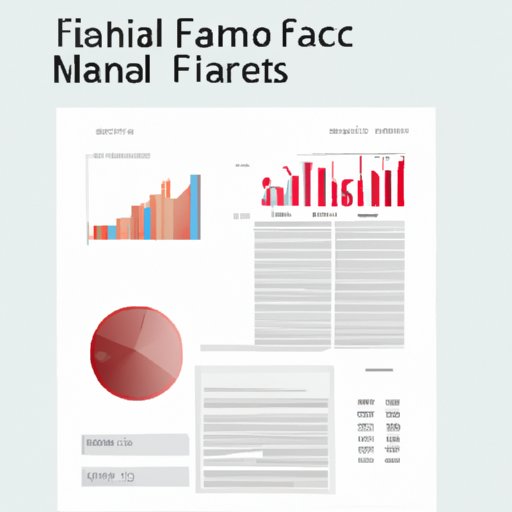Introduction
A financial report is a document that summarizes the financial position of a company. It includes a balance sheet, income statement, and cash flow statement, which provide information on the company’s assets, liabilities, equity, revenues, expenses, and cash flows. These documents are important because they provide insights into a company’s financial health and can be used to make informed decisions. In this article, we’ll explore how to read and understand a financial report in the form of a PDF.

Summarize the Key Elements of the Financial Report
The first step in understanding a financial report is to familiarize yourself with its components. Generally, a financial report consists of three main sections: a balance sheet, income statement, and cash flow statement. The balance sheet is a snapshot of a company’s assets, liabilities, and equity at a given point in time. The income statement shows the company’s revenues, expenses, and net income over a period of time. And the cash flow statement tracks the movement of cash in and out of the business.
Identify the Main Sections of the Financial Report
Once you understand the components of the financial report, the next step is to identify the main sections. The balance sheet provides a detailed breakdown of the company’s assets, liabilities, and equity. Assets are items of value owned by the company, such as cash, accounts receivable, inventory, and property. Liabilities are the company’s debts and obligations, such as accounts payable, taxes payable, and loans. Equity is the difference between assets and liabilities.
The income statement shows the company’s revenues, expenses, and net income over a period of time. Revenues are the money earned from selling goods and services. Expenses are the costs associated with running the business, such as salaries, rent, utilities, and advertising. Net income is the profit or loss resulting from the difference between revenues and expenses.
Finally, the cash flow statement tracks the movement of cash in and out of the business. It shows the cash inflows from operating activities, investing activities, and financing activities, as well as the cash outflows from the same activities. This information is important because it provides insight into the company’s liquidity and ability to pay its bills.

Explain the Components of the Balance Sheet and Income Statement
Now that you know the main sections of the financial report, the next step is to understand the components of the balance sheet and income statement. On the balance sheet, assets are listed first, followed by liabilities and equity. Assets are divided into current assets (cash, accounts receivable, inventory, etc.) and non-current assets (property, equipment, investments, etc.). Liabilities are divided into current liabilities (accounts payable, taxes payable, etc.) and non-current liabilities (loans, long-term debt, etc.). Equity is the difference between assets and liabilities.
On the income statement, revenues are listed first, followed by expenses and net income. Revenues are divided into operating revenues (sales, service fees, etc.) and non-operating revenues (interest income, dividends, etc.). Expenses are divided into operating expenses (salaries, rent, utilities, etc.) and non-operating expenses (interest expense, taxes, etc.). Net income is the difference between revenues and expenses.

Analyze the Ratios and Trends in the Financial Report
Once you understand the components of the financial report, the next step is to analyze the ratios and trends in the report. Ratios are useful tools for measuring different aspects of a company’s performance. Common ratios include the current ratio, quick ratio, debt-to-equity ratio, and return on assets. By calculating these ratios, you can get a better understanding of the company’s financial health.
In addition to ratios, it’s also important to examine the trends in the financial report. By looking at the trends in the company’s revenues, expenses, and net income over time, you can gain insights into the company’s performance and identify areas for improvement.
Discuss Ways to Use the Financial Report for Decision-Making
By understanding the components of the financial report and analyzing the ratios and trends, you can gain insights into the financial health of a company. This information can be used to make informed decisions about the company, such as whether to invest in it or not. For example, a company with a high debt-to-equity ratio may be a riskier investment than a company with a low debt-to-equity ratio.
In addition, the financial report can be used to assess the company’s performance and identify areas for improvement. By examining the trends in the income statement, you can determine which areas are performing well and which ones need to be improved.
Conclusion
Reading and understanding a financial report is an important skill for anyone involved in business. A financial report consists of three main sections: a balance sheet, income statement, and cash flow statement. By understanding the components of the financial report and analyzing the ratios and trends, you can gain insights into the financial health of a company and use the information to make informed decisions.
(Note: Is this article not meeting your expectations? Do you have knowledge or insights to share? Unlock new opportunities and expand your reach by joining our authors team. Click Registration to join us and share your expertise with our readers.)
